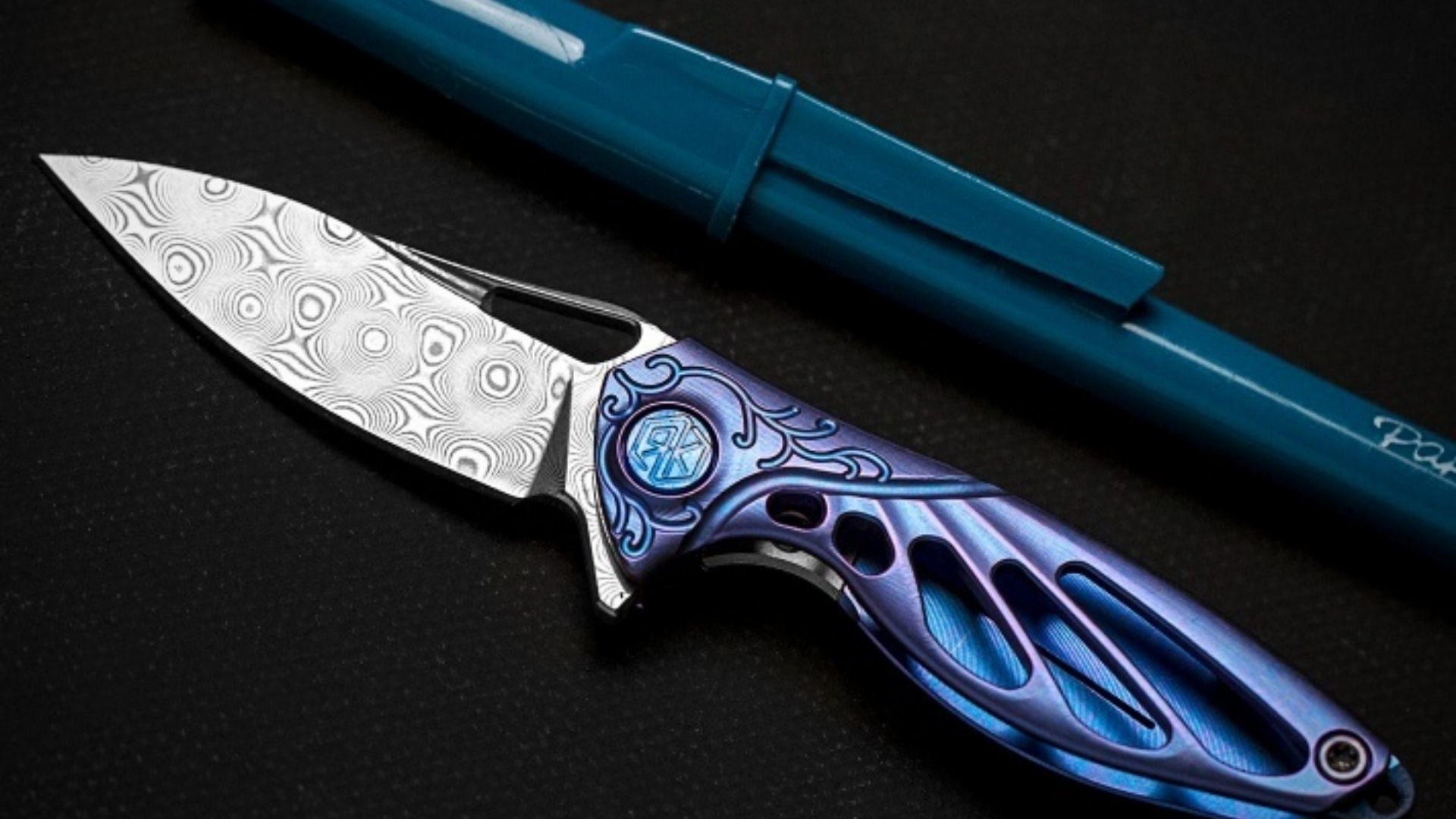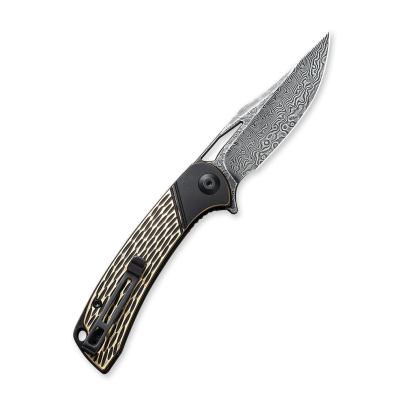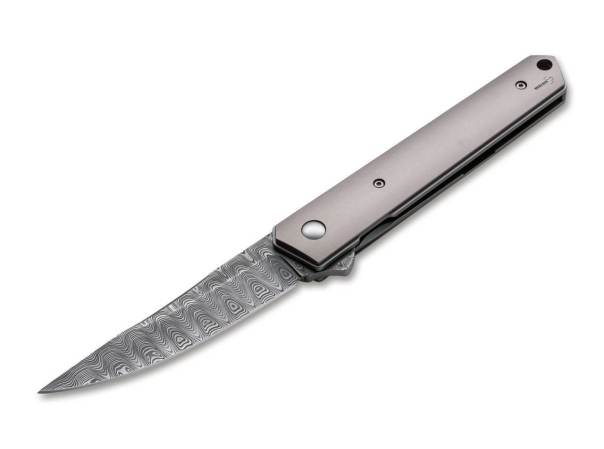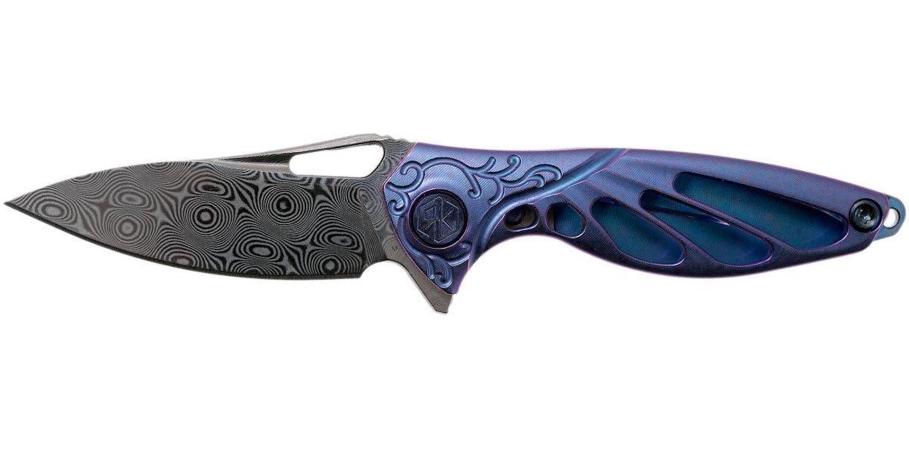We may earn revenue from the products available on this page and participate in affiliate programs.

Looking for a new knife? There are tons of options out there, but some stand out more than others. No matter the intended use, there’s one kind that’ll always catch your eye: a Damascus knife.
Damascus knives are made with special techniques that result in wavy, rippling patterns running across the blade, with the original Damascene knives dating back to at least 200 A.D. in the Middle East. Modern Damascus is made a bit differently, either forge-welded from different types of steel manipulated into a stunning pattern or from high-end stainless steels melted together in a crucible. Both methods create a unique pattern that’s unlike any other knife blade. You can find Damascus knives in just about every blade shape and for any purpose. From hunting knives, to folders, to chef’s knives, Damascus steel can be used in many different applications.
Wondering which Damascus knives are right for you? Check out our picks for the best Damascus knives and find the perfect fit for your style and needs.
Best Overall
Civivi Dogma
Best Value
Boker Magnum Rangebuster
Editor’s Choice
Boker Kwaiken Flipper
Best Budget Damasteel
Rike Hummingbird
Why you should trust us
A self-described knife nerd, I’ve dabbled in blacksmithing, martial arts, and competitive shooting in the past. My past reviews for Task & Purpose include the Cold Steel American Lawman, WE Stonefish, Leatherman Curl, Cold Steel Storm Cloud, and Spyderco Slip Stone.
Common types of Damascus knives
Damascus steel knives come in many different forms and sizes. No matter what type of knife you’re looking for, it’s highly likely that you’ll be able to find a Damascus steel version of it. While Damascus knives are made in a more complex, specialized manner than mono-steel blades, that’s exactly why they’re popular– and that means you’ll find plenty of options.
All modern Damascus-style knives are made similarly. Whether a knife is hand-forged or not, the blade is crafted from multiple-layered steel alloys. At one point this was thought to strengthen the blade by allowing it to have both the high edge retention of harder steel alloys, while retaining the damping and toughness of softer, less brittle steel alloys; however, due to the innovation of modern steel alloys, the only real benefit to modern Damascus is the aesthetics. Regardless, if you absolutely need to have a knife that looks as good as it cuts, there are a few common types of Damascus knives for you to be aware of.
Fixed blades
A fixed blade is any knife with a blade that is ‘fixed’ in place, meaning that it doesn’t have a pivot, and is firmly, immovably attached to the handle. They’re essentially the opposite of pocket knives. The blade is always exposed, unless covered by a sheath. They’re simple, easier to manufacture than folding knives, and very user friendly due to the absence of a confusing locking mechanism. Fixed blade Damascus knives come in many varieties, including hunting/skinning, survival, and chef’s knives. The better-designed fixed blades are also full-tang, where the part of the blade that’s part of the handle is the same size and shape as the handle, as this provides the greatest overall strength. The majority of Damascus fixed blades, unfortunately, are not; these knives have a thin metal ‘tail’ that is either pinned or glued inside of the handle, and are more prone to breaking.
Folding knives
Also referred to as a pocket knife, a folder is a compact knife that features one or more blades that fold up into the handle, in lieu of using a bulky sheath. Meant to fit easily inside your pocket, these knives are legal to carry in most places, and are convenient to carry and use daily. They are frequently smaller than fixed blades, with blades typically between three to four inches long, although there are many exceptions that are both longer and shorter than this. However, they’re quite handy — they can do everything from peeling an apple, to cutting small rope or twine, to doubling as a last-ditch form of protection. Though these folding knives are typically smaller and not as strong as their fixed blade siblings, they’re highly versatile.
What to look for when buying Damascus knives
Blade length
A blade that’s too long — or too short — can seriously limit how you’re able to use your Damascus knife. You want to find the right length for your most frequent uses. For example, if you need an EDC knife, a three to four inch folder will likely do the trick for most daily situations. However, if you’re using it for hunting, camping, or meal prep, you’re going to need a longer fixed blade. Another large consideration is the knife laws in your area. Obviously, you’ll want to avoid purchasing a knife that is too long for you to legally carry.
Blade shape
One of the most important things when picking out the right blade for your task, the blade shape and overall geometry can greatly impact how effective your knife is, as well how long it will last. You wouldn’t want to baton through a log with a chef’s knife, or skin a deer with a kukri. Some jobs require a thicker, stronger blade, while others require a thinner slicer blade. A knife with a super thin tip might be great for delicate, detailed work, but might break if used for chopping.
Steel type
Damascus steel can be made with many different types of steel. There are also various methods of making it, with a wide range of quality. In general, it’s easiest to just avoid any Damascus knives that are cheap, made in the Middle East/India, and advertised as ‘handmade’.
There are some decent, inexpensive, pattern-welded Damascus blades out there, but they can be hard to pick out from the poor quality ones if you don’t know what to look for. We’d advise only buying Damascus from reputable, well known companies, and to stick with either stainless Damascus or Damasteel if possible. However, depending on your intended use, you might have to go with pattern-welded steel, as high carbon steels tend to offer better toughness.
The most common types of Damascus knives
Pattern-welded Damascus steel
By far the most common way of making Damascus-style steel, this variant is made by forge-welding at least two dissimilar metals together. After they are forge-welded together, they are folded and welded again repeatedly to form an ingot, drawn out and formed into the basic shape of the blade, heat-treated, tempered, and ground; The blade is then dipped in acid to patina the blade and bring out the final pattern of the folded layers of steel. Ferric Chloride acid is frequently used, and 1095 and 15N20 are frequent high carbon steel choices for pattern-welded Damascus, due to the high-nickel content of 15N20 making it patina drastically lighter than 1095, which creates strikingly bold patterns.
The billet is heated, hammered, and folded repeatedly. The distinct patterns on the blade are created by twisting, folding and drawing out the billet. Overall, the process creates a very strong blade, but its durability is due to the steel alloys that are chosen to create the blade. The pattern in damascus steel is only visually revealed once the steel is cleaned, prepared and etched in acid. The two types of steel react differently in the acid oxidation process. One oxidized steel is lighter and the other is darker, only then is the pattern revealed on the surface that is hidden within the steel.
Stainless Damascus
Depending on the steels/metals used, Damascus steel can be stainless or not. To become a stainless Damascus both steels must have at least 14% chromium. While the most notable advantage to this is a drastic increase in corrosion resistance, there’s typically an increase in quality as well, as this is harder to make than pattern-welded Damascus.
Damasteel
Damasteel is a modern, innovative take on Damascus steel that utilizes particle metallurgy (PM) to produce extremely high quality stainless Damascus that performs very similarly to CPM154 steel, and has drastically less impurities and inclusions than pattern-welded Damascus. It also features improved toughness and edge retention, courtesy of the PM process. This is the most expensive option, but you get what you pay for.
Pricing considerations for Damascus knives
Budget
Plenty of Damascus knives are budget-friendly and priced at $60 or less. You’ll find quite a few pocket knives, survival knives, and hunting knives within this price range. Beware of Damascus knives in this price range that are made in the Middle East/India and advertised as ‘handmade’.
Mid-range
If you’re looking for a more specialized Damascus knife like a chef’s knife, a quality hand-forged blade, or one made from stainless steel Damascus, you’ll find those mid-tier options in the $60 to $150 range.
Premium
Only accepting the best of the best? You’ll want to look in the $150 and up price range. Here’s where you’ll find your high end chef’s knives, damasteel, and custom blades.
How we chose our top picks
We chose our top picks by looking at Damascus knives at various price points, then assessing which had the best customer reviews and highest ratings. We then examined the durability and versatility, along with the materials and quality control that went into making each knife, and tested each knife individually.
FAQs on Damascus knives
You’ve got questions, Task & Purpose has answers.
Q. How good is Damascus steel for knives?
A: It varies greatly, but quality Damascus is perfectly fine, it’s worth noting that nothing currently on the market outperforms mono-steels like CPM S35VN or other common premium steels. And unfortunately, the cheaper, low quality Damascus that is frequently peddled can have serious issues, including poor edge retention, delamination, and rust.
Q. Do Damascus Knives rust?
A: Any steel will rust, given the right conditions and a high enough carbon content, but you’ll mainly see corrosion on pattern-welded Damascus that uses high-carbon steels like 1095. It’s imperative that you keep non-stainless Damascus properly maintained to prevent the slightest chance of rust.
Q. Do Damascus knives hold an edge better?
A: It depends on what you’re comparing them to, but in general, most premium blade steels like CPM S35VN will consistently hold a better edge for longer.
Q. How should I maintain my Damascus knife?
A: If it is made using carbon or high carbon steels, you’ll want to keep it clean, to prevent any dirt buildup from allowing moisture to collect and cause rust. By the same token, you’ll also want to dry off the blade as soon as possible after being exposed to water, and wipe it down every other week or so with a thin layer of oil– more frequently, if you live in a humid environment. It’s also best to not store it in its sheath, as moisture can collect in there, without much chance to evaporate. Stainless Damascus and Damasteel are vastly easier to maintain– just keep them clean and dry, and they’ll be happy.
Q. Should I buy a cheap pattern-welded Damascus knife?
A: Lol, no. I can’t stress how much of a waste of money these are.
Our gear section
Josiah Johnston is an active-duty Marine stationed at Camp Pendleton, originally from the Eastern Panhandle of West Virginia. He’s dabbled in blacksmithing, martial arts, competitive shooting, and is a self-described knife nerd.






